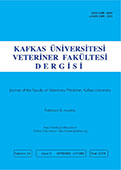
This journal is licensed under a Creative Commons Attribution-NonCommercial 4.0 International License
Kafkas Üniversitesi Veteriner Fakültesi Dergisi
2018 , Vol 24 , Issue 5
Bimanual Capsulorhexis Using a New Hand Tool: An Experimental Study in Sheep Eye
1Near East University School of Medicine, Department of Ophthalmology, 99138 Lefkoşa, TRNC2Department of Surgery, Faculty of Veterinary Medicine, Near East University, 99138 Lefkoşa, TRNC
3Near East University Innovation and Information Technologies Center, NEURobotics Lab, 99138 Lefkoşa, TRNC DOI : 10.9775/kvfd.2018.20031 The purpose of this study was to design a cheap and easy-to-use hand tool that allows a better-centered capsulorhexis of consistent shape and size for inexperienced and experienced surgeons in cataract surgery. Forty-five eyes of dead adult sheep from a local slaughterhouse were grouped as; group 1, the continuous curvilinear capsulorhexis (CCC) group (n: 15); group 2, the cerclage wire group (n: 15); and group 3, the polylactic acid (PLA) hand tool group (n: 15). In group 1, one corneal incision was made. In groups 2 and 3, two incisions were made at 3:00 and 11:00 o"clock directions. Methylene blue was used for capsular staining. After injecting viscoelastic into the anterior chamber and the capsule was punctured, the devices were inserted at 3:00 o"clock. All capulorhexes were performed using the Utrata forceps following the internal contour of the devices. As a result of the study, capsulorhexes were successfully performed in 9 of 15 eyes in group 1; 2 of 15 eyes in group 2; and 12 of 15 eyes in group 3. Statistically, the correlation between the distributions of groups 1 and 2 (χ²=7.033, P=0.008); and for groups 1 and 3 (χ²=6.171, P=0.002) were found to be significant. This study showed that CCC was performed using the newly designed PLA hand tool more successfully than the classical method by the beginning surgeon. Keywords : Polylactic acid, Capsulorhexis, Continuous curvilinear capsulorhexis, Cataract surgery










